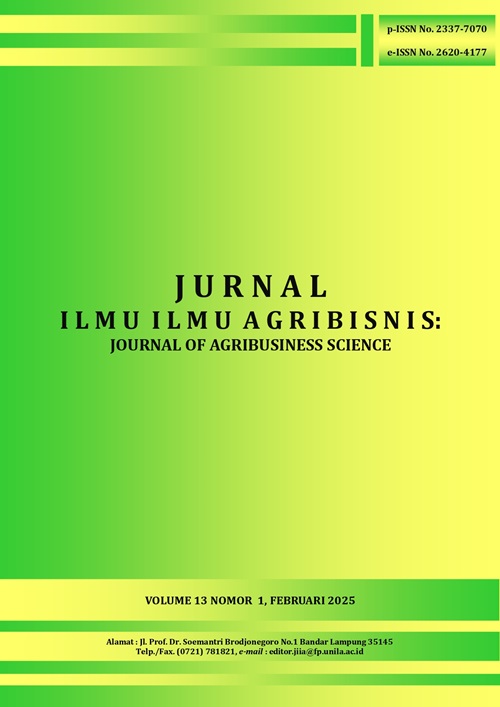ANALISIS PREFERENSI, POLA KONSUMSI, DAN PERMINTAAN CABAI HIJAU TINGKAT RUMAH TANGGA DI KOTA BANDAR LAMPUNG
DOI:
https://doi.org/10.23960/jiia.v13i1.9796 Abstract View: 166
Abstract View: 166
Abstract
The purpose of this study was to analyze preferences, consumption patterns and factors that influence household level consumption of green chilies in Bandar Lampung City. The research method used is the survey method. Data collection was carried out in November – December 2023 with a total of 70 household sample. Sampling was carried out in four sub-districts, namely Sukarame sub-district, Way dadi sub-district, Pesawahan sub-district, and Gunung Mas sub-district. The data analysis used is conjoint analysis, descriptive analysis, and multiple linear regression analysis. The results of the research show that household preferences in Bandar Lampung City for green chilies are spicy, lowest price (<Rp20.000), fresh, bright green, and curly green chilies. Households consume chilies in the form of chili sauce or mixed dishes with an average weekly consumption per capita of 0,019 kg. Households also consume curly green chilies. Purchases are only made once a month at traditional markets. The average household consumes green chilies only 1-2 times a month. Factors that have a significant influence on household demand for green chilies in Bandar Lampung City are the price of green chilies and the number of household members.
Key words: chili, consumption pattern, demand, preference
Downloads
Downloads
Published
How to Cite
Issue
Section
License
Authors who publish with this journal agree to the following terms:
Authors retain copyright and grant the journal right of first publication with the work simultaneously licensed under a Creative Commons Attribution License that allows others to share the work with an acknowledgement of the work's authorship and initial publication in this journal.
Authors are able to enter into separate, additional contractual arrangements for the non-exclusive distribution of the journal's published version of the work (e.g., post it to an institutional repository or publish it in a book), with an acknowledgement of its initial publication in this journal.
Authors are permitted and encouraged to post their work online (e.g., in institutional repositories or on their website) prior to and during the submission process, as it can lead to productive exchanges, as well as earlier and greater citation of published work (See The Effect of Open Access).














